
A quick check list to give to student videographers ome basic rules of filming, particularly when using a cell phone video camera.
- Subject:
- Arts and Humanities
- Career and Technical Education
- Material Type:
- Lesson
- Date Added:
- 01/24/2016

A quick check list to give to student videographers ome basic rules of filming, particularly when using a cell phone video camera.
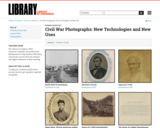
Photographs that help to document the photographic technologies used during the Civil War. This set also includes a Teacher's Guide with historical context and teaching suggestions.
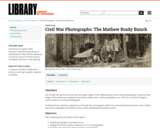
Students use Library of Congress primary sources to examine Civil War photographs as primary sources.
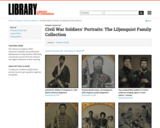
A selection of Library of Congress primary sources exploring the Civil War portraits in the Liljenquist Family Collection of Civil War Photographs from the Library of Congress. This set also includes a Teacher s Guide with historical context and teaching suggestions.

SYNOPSIS: In this lesson, students watch videos and learn about photography to implement photography techniques in their stop motion projects.
SCIENTIST NOTES: This lesson focuses on photographic stop motion animation techniques. Climate change can be a part of this lesson. All materials used in the lesson have been verified and are suitable for teaching. In this light, this lesson is credible and recommended for the classroom.
POSITIVES:
-The photography and stop motion video examples are all related to climate change to spark intrigue and start discussions.
-There is deep learning about photography techniques.
ADDITIONAL PREREQUISITES:
-This is lesson 3 of 4 in our 3rd-5th grade Animate for the Animals unit.
-The teacher will need to organize worksheets for students.
-The teacher will need to ensure that there are devices available if the Investigate section is done individually or in small groups.
DIFFERENTIATION:
-Student partners could be chosen by the teacher to ensure good academic and social balance.
-Students could explore the Investigate section in groups instead of having the teacher lead the discussion. The whole class could come back together to discuss their new knowledge after the groups are finished.

Ranu Mukherjee creates "Hybrid films" using layers of video, paintings and collage to create moving images. In the latest episode of Art School, Mukherjee unpacks the narrative and details behind her newest piece, Home and the World, which examines cultural hybridity, the aftermath of colonialism, and feminist questions. Inspired by a scene from a film by Satyajit Ray, as well as the composition of traditional Indian lithographs, Mukherjee combined these influences with her own visual culture to create a subtle but complex moving image.
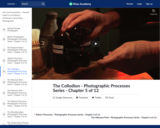
Introduced in 1851, by Frederick Scott Archer, the wet collodion process was a fairly simple, if somewhat cumbersome photographic process. A 2% solution of collodion, bearing a very small percentage of potassium iodide, was poured over a plate of glass, leaving a thin, clear film containing the halide. The plate was then placed in a solution of silver nitrate. When removed from the silver, the collodion film contained a translucent yellow compound of light-sensitive silver iodide. The plate was exposed still wet and then developed by inspection under red light. Once the plate was washed and dried, it was coated with a protective varnish. The collodion process replaced the daguerreotype as the predominant photographic process by the end of the 1850’s. It was eventually replaced in the 1880’s with the introduction of the gelatin silver process. This project is made possible by a grant from the U.S. Institute of Museum and Library Services, grant number MA-10-13-0194.
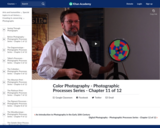
Photography’s earliest practitioners dreamed of finding a method for reproducing the world around them in color. Some 19th century photographers experimented with chemical formulations aimed at producing color images by direct exposure, while others applied paints and powders to the surfaces of monochrome prints. Vigorous experimentation led to several early color processes, some of which were even patented, but the methods were often impractical, cumbersome and unreliable. This chapter explores early additive color processes as well as later subtractive processes like chromogenic color and the Kodachrome. This project is made possible by a grant from the U.S. Institute of Museum and Library Services, grant number MA-10-13-0194.
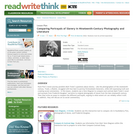
In this lesson, students analyze similarities and differences among depictions of slavery in "The Adventures of Huckleberry Finn", Frederick Douglass' "Narrative", and nineteenth century photographs of slaves. Students formulate their analysis of the role of art and fiction, as they attempt to reliably reflect social ills, in a final essay.

In this interdisciplinary seminar, we explore a variety of visual and written tools for self exploration and self expression. Through discussion, written assignments, and directed exercises, students practice utilizing a variety of media to explore and express who they are.

Students interview family members, and then create graphic family timelines based on important and memorable family events.

Almost 1400 photographs, primarily studio portraits of people involved in the arts, including musicians; dancers; artists; literati; theatrical, film, and television actors and actresses. Includes black entertainers, particularly those associated with the Harlem Renaissance. Most are individual portraits, but also includes some group portraits. Sitters represented in ten or more photos are: Judith Anderson, Tallulah Bankhead, Anton Dolin, Ram Gopal, Hugh Laing, Alicia Markova, and Ethel Waters. A much smaller portion of the collection is an assortment of American landscapes.
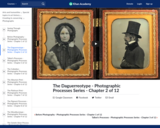
The first commercially successful photographic process was announced in 1839, the result of over a decade of experimentation by Louis Daguerre and Nicéphore Niépce. Unfortunately, Niépce died before the daguerreotype process was realized, and is best known for his invention of the heliograph, the process by which the “first photograph” was made in 1826. Daguerreotypes are sharply defined, highly reflective, one-of-a-kind photographs on silver-coated copper plates, usually packaged behind glass and kept in protective cases. The daguerreotype process is demonstrated in this chapter. This project is made possible by a grant from the U.S. Institute of Museum and Library Services, grant number MA-10-13-0194.
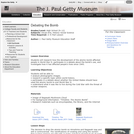
Students will research how the development of the atomic bomb affected people in World War II, participate in a debate about the bomb's use, and investigate how it has affected people's lives since 1945.
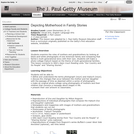
Students examine the roles of mothers and grandmothers by looking at black-and-white photographs of one American family and comparing that family's multi-generational story with their own. Students will make a photo-collage triptych based on the theme of multi-generational families. This lesson connects to SRA's "Open Court Reading" units "Our Country and Its People" and "Sharing Stories."
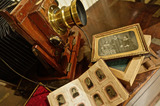
This historical survey course covers image capture techniques from the camera obscura through current digital technologies. In this portion of the material you will learn the formula in which the daguerrotype (or tin type) photograph was made.

Kodak engineer Steven Sasson invented the digital camera in 1975. Within 25 years the technology would overtake analog film materials and dominate the photographic industry and practice. This chapter features a timeline of digital camera technology starting with Steven Sasson’s first completely digital camera prototype and takes us all the way to the smart phones of today. This project is made possible by a grant from the U.S. Institute of Museum and Library Services, grant number MA-10-13-0194.

Striking images can leave lasting impressions on viewers. In this lesson, students make text-self-world connections to a nature- or science-related topic as they collaboratively design a multimedia presentation.
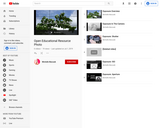
Playlist of digital photography tutorials on advanced photographic techniques relating but not limited to comprehension and execution of visual communication through photography, camera use techniques, studio and natural lighting techniques, pre-production, post-production and digital editing.

My submission for the ISKME GoPro Learning Challenge: Draw, build and walk a labyrinth documenting the process in video and photography! Use the experience and images for self-reflection and to inspire others.. .